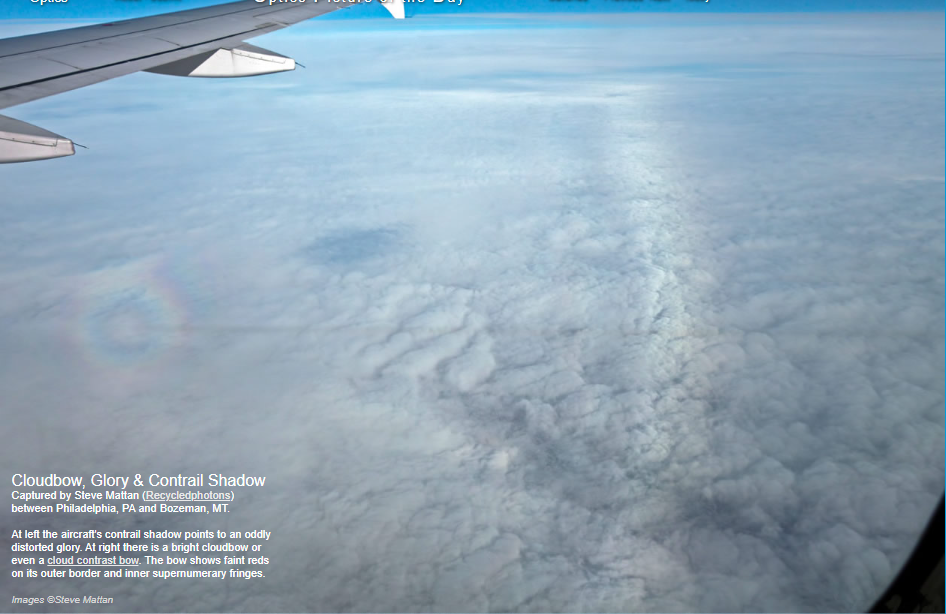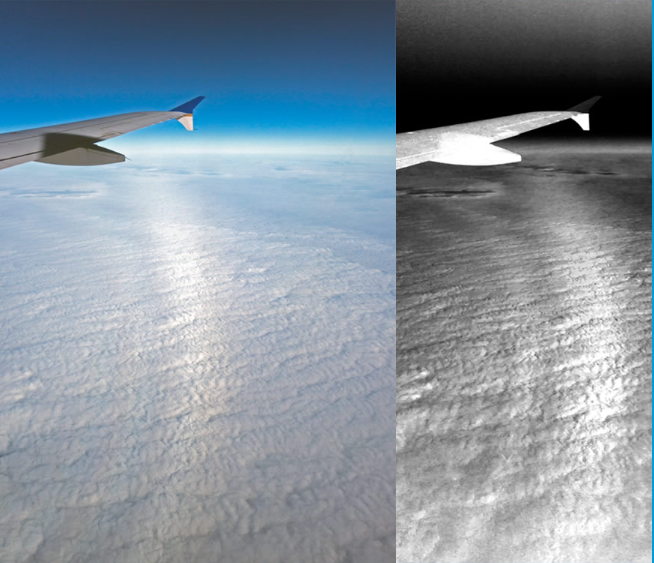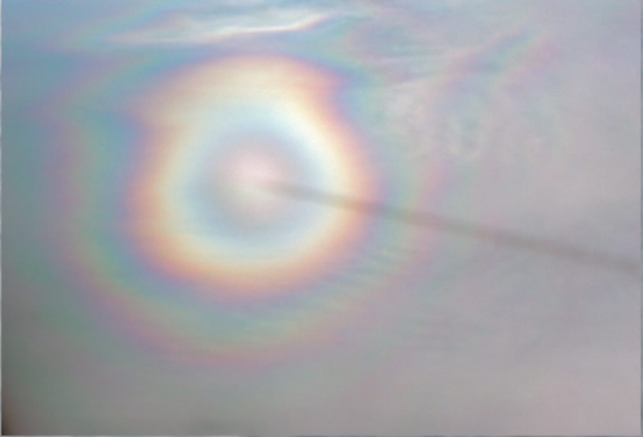Cloudbow and Glory - OPOD
Cloudbow and Glory: A Captivating Atmospheric Phenomenon
Have you ever looked up at the sky and been captivated by the beauty and mystery of the clouds? The world above us is filled with remarkable atmospheric optics phenomena that can leave us in awe. One such phenomenon is the cloudbow and glory, which are both part of the same diffraction pattern produced by sunlight scattering through small droplets at the cloud tops.
Understanding the Cloudbow
The cloudbow is a smaller cousin of the more well-known rainbow formed by raindrops. It occurs when sunlight is reflected once within a droplet, resulting in a beautiful bow-shaped display. Unlike the rainbow, the cloudbow exhibits faint reds on its outer border and inner supernumerary fringes. These supernumeraries are additional bands of colors that appear more highly colored than the main bow, adding to the enchantment of this optical phenomenon.
The Glory: A Complex Display
The glory, on the other hand, is a more complex optical phenomenon. It occurs when light waves are internally reflected multiple times within a droplet, ranging from 5 to 10 reflections. Additionally, the waves have to travel part of their journey along the drop surface. The result is a series of concentric rings of colors surrounding a bright central spot. Interestingly, variations in droplet size across the clouds play a significant role in the size of the glory. Smaller droplets tend to create larger glories, adding another layer of intrigue to this captivating atmospheric display.
Exploring the Cloud Contrast Bow
While observing the cloudbow, you may notice a contrast between the clouds themselves. In some instances, rays from the cloud tops are scattered by a single droplet, generating a bright cloudbow. However, sun rays entering hollows between the clouds can be scattered multiple times, resulting in a diminished cloudbow. As a result, the hollows appear darker compared to the cloud tops, which shine brighter with cloudbow light. This contrast adds depth and complexity to the overall visual experience.
Supernumeraries: An Added Delight
If you're lucky, you may even spot supernumeraries within the cloudbow or glory. These are additional bands of colors that appear alongside the main bow or glory. Interestingly, cloudbow and fogbow supernumeraries tend to be more highly colored than the main bow or glory. These delicate features are caused by the interference of light waves and add an extra touch of beauty to an already enchanting atmospheric optics display.
Capturing the Magic
Photographers and sky enthusiasts are often drawn to the mesmerizing beauty of the cloudbow and glory. Capturing these elusive phenomena can be a challenging yet rewarding experience. The key lies in being at the right place at the right time, when the atmospheric conditions are just perfect for these displays to occur. Armed with a camera, patience, and a keen eye, one can capture breathtaking images that showcase the splendor of these optical marvels.
Conclusion
The cloudbow and glory are two mesmerizing atmospheric optics phenomena that never fail to leave us in awe. As sunlight interacts with tiny droplets in the clouds, it creates stunning displays of colors and patterns that add a touch of magic to our skies. Whether you're lucky enough to witness these phenomena firsthand or admire them through photographs, the cloudbow and glory remind us of the wonders that exist in our natural world. So next time you find yourself gazing at the clouds, take a moment to appreciate the hidden beauty that lies within.

Cloudbow, Glory & Contrail Shadow Captured by Steve Mattan (Recycledphotons) between Philadelphia, PA and Bozeman, MT.
At left the aircraft's contrail shadow points to an oddly distorted glory. At right there is a bright cloudbow or even a cloud contrast bow. The bow shows faint reds on its outer border and inner supernumerary fringes.
Images ©Steve Mattan

Supernumeraries
The colour subtraction enhancement at far right hints at three supernumeraries. Cloudbow and fogbow supernumeraries are more highly coloured - as here - than the main bow.
The glory and cloudbow are all part of the same diffraction pattern produced by sunlight scattering by small droplets at the cloud tops.
The cloudbow, small droplet cousin of the much larger raindrop rainbow, results from a single reflection of light waves in a droplet.
The glory is more complex. waves are internally reflected 5, 6 and even 10 times. Plus, the waves have to travel part of their journey along the drop surface.
Cloud Contrast Bow?
The contrast between the clouds appears greater in the cloudbow. If real, it arises because rays from the cloud tops are scattered by a single droplet and generate the cloudbow. Sun rays entering hollows between the clouds can be scattered several times and then do not give a bright cloudbow. The hollows are as dark as elsewhere but the cloud tops shine brighter with cloudbow light.

Distorted Glory
Nothing to do with the shapes of the cloud tops or distances of the droplets making it.
Everything to do with variations in droplet size across the clouds. Smaller droplets make larger glories.

Note: this article has been automatically converted from the old site and may not appear as intended. You can find the original article here.
Reference Atmospheric Optics
If you use any of the definitions, information, or data presented on Atmospheric Optics, please copy the link or reference below to properly credit us as the reference source. Thank you!
-
<a href="https://atoptics.co.uk/blog/cloudbow-and-glory-opod/">Cloudbow and Glory - OPOD</a>
-
"Cloudbow and Glory - OPOD". Atmospheric Optics. Accessed on December 22, 2024. https://atoptics.co.uk/blog/cloudbow-and-glory-opod/.
-
"Cloudbow and Glory - OPOD". Atmospheric Optics, https://atoptics.co.uk/blog/cloudbow-and-glory-opod/. Accessed 22 December, 2024
-
Cloudbow and Glory - OPOD. Atmospheric Optics. Retrieved from https://atoptics.co.uk/blog/cloudbow-and-glory-opod/.